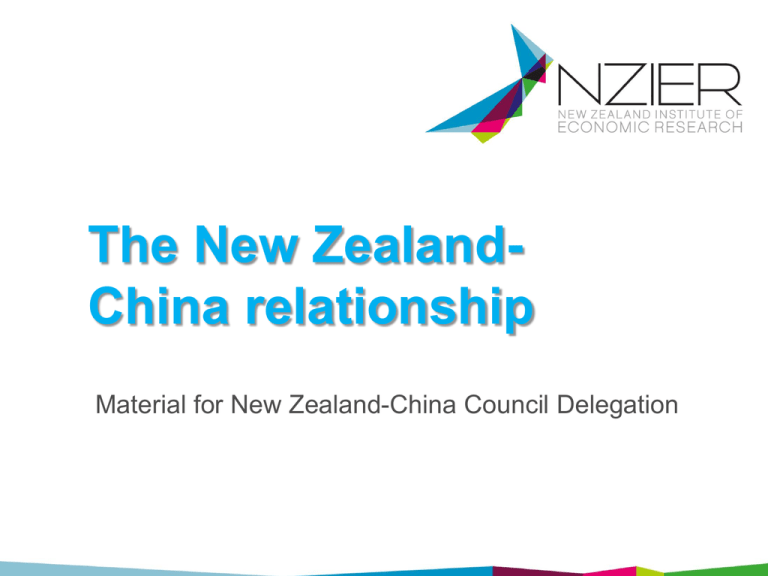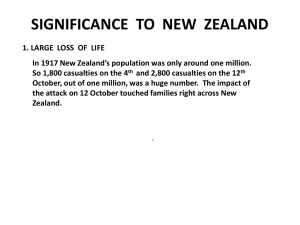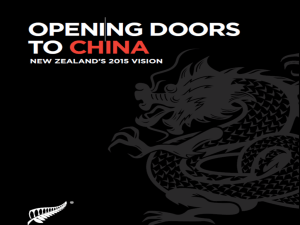The New Zealand- China relationship
advertisement

The New ZealandChina relationship Material for New Zealand-China Council Delegation China is a central part of a huge structural shift in the global economy… Source: OECD 2 …and New Zealand is responding to that shift Goods exports to China have risen from $2 billion to $7 billion in 5 years during a global recession Source: Statistics New Zealand 3 From humble beginnings… Source: Statistics New Zealand 4 …China is NZ’s hottest export market and eased the pain of the global financial crisis China is responsible for $4.9bn of NZ's additional $9.5bn of exports since 2007 5 Trade is becoming more balanced Source: Statistics New Zealand 6 Strong growth in top 7 exports to China Source: Statistics New Zealand 7 An increasingly important source of imports… Source: Statistics New Zealand 8 …that are used by households and New Zealand firms for further production Top 10 = ~82% of total Source: Statistics New Zealand 9 Exports of services are growing too: Chinese tourism spending has risen strongly Since GFC hit, Chinese tourism spending has risen by $380 million. Total spending by all tourists fell by $720 million. 10 Tourism market is changing rapidly, driven by Chinese income growth Expect visitors from China to double by 2018 New Zealand tourism operators needs to think carefully about Chinese visitors’ demands Source: NZIER, MBIE 11 Commercial services exports are small but widespread and growing Source: Statistics New Zealand Overall, China is now New Zealand’s 3rd largest services market, worth over $1 billion per year and growing 12 New Zealand remains a popular place for Chinese students to learn Chinese students accounted for $560 million of GDP in 2011: 27% of the total GDP generated by overseas students Sources: http://www.educationcounts.govt.nz; Infometrics 13 Investment has risen – both ways Only 0.61% of New Zealand’s total stock of foreign investment is from China… …compared with 16% of our total imported goods Of New Zealand’s total investment abroad, China received 0.59% in 2012, up from 0.13% in 2007 Source: Statistics New Zealand 14 FTA provides a competitive edge • • • • Total trade with Growth since Growth since 2000 2008 Growth since 2010 World 55% 2% 9% China 411% 62% 26% 91% of tariff lines are duty free By 2016, all imports from China will be duty free By 2019, 96% of New Zealand exports will be duty free Leaders’ goal of doubling exports within 5 years from 2010 is an ambitious but feasible target 15 But FTA preferences won’t last forever: we need to maximise our first-mover advantage China’s signed FTAs In negotiation or being considered* ASEAN GCC Pakistan Australia Chile Iceland New Zealand Norway Singapore SACU Peru India* Hong Kong Japan and Korea* Macau Switzerland* Costa Rica RCEP Product NZ FTA tariff 2013, 2019 MFN tariff 2013 Milk & cream 5%, 0% 10% Kiwifruit 6.7%, 0% 20% Chilled lamb 5%, 0% 15% 16 Chinese economic challenges present opportunities for New Zealand firms Challenge Potential implications for New Zealand Environmental pressures More demand for exports of environmental goods, services and technology (e.g. energy-efficient materials) Rapid urbanisation Demand for New Zealand building products Food security and availability Food exports; technical cooperation to boost Chinese agricultural productivity; greater ‘exports of experts’ Rebalancing of economy away from investment towards consumption Should boost Chinese demand for imports of consumables, including foodstuffs, wine, fashion, etc. Fiscal pressures related to healthcare and education spending Enhanced demand for health technologies, opportunities for education via JVs/commercial presence Regional integration models: TPP vs. RCEP New Zealand has a strong interest in TPP accession clause accommodating future Chinese entry; can act as neutral ‘bridge’ between RCEP and TPP 17 Key takeouts • The economic relationship has developed rapidly and is maturing well • It’s more than just goods exports – the services, investment and people links are deepening • The FTA has generated real momentum • But preferential tariff advantage will be eroded over time as both countries sign more FTAs with other competitors • Opportunities abound for New Zealand firms to help address big structural challenges in China 18








